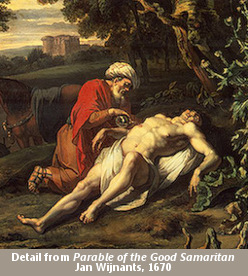The Original Good Samaritans

When I was a child, I enjoyed reading Highlights Magazine, a publication for children; the magazine is still flourishing in 2012. One continuous feature of Highlights is a sketch with carefully concealed objects that blend into the picture. In today’s article, I encourage you to sleuth the hidden objects common to two Bible texts.
Most Christians are familiar with Jesus’ parable of the Good Samaritan found in Luke 10:30-35. Jesus was responding to the question, “Who is my neighbor?” by means of this story. Lois Tverberg, in her book, Walking in the Dust of Rabbi Jesus, suggests this parable is based upon a passage in 2 Chronicles 28. I agree.
You remember the essentials of the parable, don’t you? A Jewish man was going toward Jericho and was accosted by robbers who left him half dead. A priest and Levite (fellow Jews) passed by and ignored this man’s plight. A man from the despised Samaritan people, however, walked by and had compassion on the man. Luke 10:34-35 reads,
He [the Samaritan] went to him and bound up his wounds, pouring on oil and wine. Then he set him on his own animal and brought him to an inn and took care of him. And the next day he took out two denarii and gave them to the innkeeper, saying, “Take care of him, and whatever more you spend, I will repay you when I come back.” (ESV)
The tradition of the Good Samaritan, however, seems to originate in an obscure passage, 2 Chronicles 28:15. The soldiers of the Northern Kingdom of Israel—Samaria—had slaughtered 120,000 Judeans and captured another 200,000 as slaves. The prophet Obed spoke a word to the Lord shaming the Samaritan Jews and admonishing them to return the captive Judeans to their homeland. Surprisingly, the people responded. As we read the response, look for evidence suggesting that the Good Samaritan parable is a midrash (elaboration) upon these historical events. See how many similarities you can note.
And the men…rose and took the captives, and with the spoil they clothed all who were naked among them. They clothed them, gave them sandals, provided them with food and drink, and anointed them, and carrying all the feeble among them on donkeys, they brought them to their kinsfolk at Jericho, the city of palm trees. Then they returned to Samaria.
Do you catch the similarities? The city of Jericho is mentioned in both accounts. The people were clothed, given sandals, provided for, anointed, and carried on a donkey. The victims in both instances were Judeans while the heroes were Samaritans.
There are, of course, many differences between these accounts. We have a massive group involved in the 2 Chronicles passage, while only individuals are mentioned in Jesus’ parable. The Samaritans mentioned in the 2 Chronicles account were not the mixed race of Samaritans that existed at the time of Jesus. Ironically, the Samaritan Jews of 2 Chronicles (who were “racially pure”) were idolatrous while the Samaritans of Jesus’ day (of a mixed Jewish and gentile race) worshipped the one true God apart from idols.
In both the historical account and the parable, the emphasis is upon treating people humanely. Compassion is a key word. In the earlier instance, the people had to be admonished by a prophet before they would do the proper and compassionate thing. In the parable, the Samaritan’s conscience and heart were the driving force. No one but he and God could witness his actions.
As I look at both of these texts, I am reminded of something true about myself, and, I believe, each one of us. As a disciple of Jesus Christ, I am accountable directly to him. He leads me through His Word and His Spirit, and, as I walk in the Spirit, I will manifest the fruit of the Spirit, which is love.
Yet sometimes I must be admonished to do the right thing. Like the Samaritan Jews who had intended to enslave their Judean brothers, I sometimes need to be motivated to do the right thing. This is one reason why I need the Body of Christ, as do you.
I have long marveled at how many Christians consider church attendance and church involvement optional. Sunday is considered a family day; if we have no particular activity on a certain Sunday, then we will go to church. If we can find something more fun to do, then we will do it. The concept of Sunday being “The Lord’s Day” seems all but lost.
Church attendance is not necessary for salvation. We are saved by grace alone through faith alone in Christ alone. But church attendance and involvement (“body life”) are necessary for discipleship and balanced spiritual maturity. Like a piece of chicken on the grill that is never turned over, some believers are burnt on one side and raw on the other. We need both an individual walk and a corporate experience.
I am not among those who legalistically believe a believer has to attend church every Sunday without fail. Family reunions or rare events do sometimes legitimately preclude church, in my view. But the default setting needs to be, “Church attendance is a priority.” Why? Is it just about giving the Lord the first day of our week or about obeying the concept of Hebrews 10:25? Yes, those are valid reasons. But we also need to hear God’s Word preached, and we need the church body. We sometimes resemble the Jews of 2 Chronicles 28, on the verge of doing the wrong thing.
God speaks not only through the man preaching the Word, but He speaks through the Body as we share in Sunday School or fellowship after the service. He speaks through songs and prayers and testimonies. Obed the prophet is not handy to confront us, but the fellowship of believers is even more special. Fellow believer: you need us and we need you.
The original Good Samaritans were not so good. But they did the right thing and became “good” because they heard and obeyed the Word of the Lord. The ideal is to be like the Samaritan man of the parable, but we are not always the ideal. Sometimes we need an Obed.
Ed Vasicek Bio
Ed Vasicek was raised as a Roman Catholic but, during high school, Cicero (IL) Bible Church reached out to him, and he received Jesus Christ as his Savior by faith alone. Ed earned his BA at Moody Bible Institute and served as pastor for many years at Highland Park Church, where he is now pastor emeritus. Ed and his wife, Marylu, have two adult children. Ed has published over 1,000 columns for the opinion page of the Kokomo Tribune, published articles in Pulpit Helps magazine, and posted many papers which are available at edvasicek.com. Ed has also published the The Midrash Key and The Amazing Doctrines of Paul As Midrash: The Jewish Roots and Old Testament Sources for Paul's Teachings.
- 58 views

Discussion